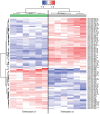Angiotensin receptor blocker telmisartan inhibits cell proliferation and tumor growth of cholangiocarcinoma through cell cycle arrest
- PMID: 29075786
- PMCID: PMC5673010
- DOI: 10.3892/ijo.2017.4177
Angiotensin receptor blocker telmisartan inhibits cell proliferation and tumor growth of cholangiocarcinoma through cell cycle arrest
Abstract
Cholangiocarcinoma (CCA) is at an advanced stage at the time of its diagnosis, and developing a more effective treatment of CCA would be desirable. Angiotensin II type 1 (AT1) receptor blocker (ARB), telmisartan may inhibit cancer cell proliferation, but the mechanisms by which telmisartan affects various cancers remain unknown. In this study, we evaluated the effects of telmisartan on human CCA cells and to assess the expression of microRNAs (miRNAs). We studied the effects of telmisartan on CCA cells using two cell lines, HuCCT-1 and TFK-1. In our experiments, telmisartan inhibited the proliferation of HuCCT-1 and TFK-1 cells. Additionally, telmisartan induced G0/G1 cell cycle arrest via blockade of the G0 to G1 cell cycle transition. Notably, telmisartan did not induce apoptosis in HuCCT-1 cells. This blockade was accompanied by a strong decrease in cell cycle-related protein, especially G1 cyclin, cyclin D1, and its catalytic subumits, Cdk4 and Cdk6. Telmisartan reduced the phosphorylation of EGFR (p-EGFR) and TIMP-1 by using p-RTK and angiogenesis array. Furthermore, miRNA expression was markedly altered by telmisartan in HuCCT-1. Telmisartan inhibits tumor growth in CCA xenograft model in vivo. In conclusion, telmisartan was shown to inhibit human CCA cell proliferation by inducing cell cycle arrest.
Figures







Similar articles
-
The angiotensin II type 1 receptor antagonist telmisartan inhibits cell proliferation and tumor growth of esophageal adenocarcinoma via the AMPKα/mTOR pathway in vitro and in vivo.Oncotarget. 2017 Jan 31;8(5):8536-8549. doi: 10.18632/oncotarget.14345. Oncotarget. 2017. PMID: 28052030 Free PMC article.
-
Telmisartan inhibits hepatocellular carcinoma cell proliferation in vitro by inducing cell cycle arrest.Oncol Rep. 2017 Nov;38(5):2825-2835. doi: 10.3892/or.2017.5977. Epub 2017 Sep 20. Oncol Rep. 2017. PMID: 29048654 Free PMC article.
-
Lobaplatin induces apoptosis and arrests cell cycle progression in human cholangiocarcinoma cell line RBE.Biomed Pharmacother. 2012 Apr;66(3):161-6. doi: 10.1016/j.biopha.2011.09.008. Epub 2011 Dec 29. Biomed Pharmacother. 2012. PMID: 22425181
-
Curcumin-mediated regulation of Notch1/hairy and enhancer of split-1/survivin: molecular targeting in cholangiocarcinoma.J Surg Res. 2015 Oct;198(2):434-40. doi: 10.1016/j.jss.2015.03.029. Epub 2015 Mar 19. J Surg Res. 2015. PMID: 25890434 Review.
-
Benefits of Metformin Use for Cholangiocarcinoma.Asian Pac J Cancer Prev. 2015;16(18):8079-83. doi: 10.7314/apjcp.2015.16.18.8079. Asian Pac J Cancer Prev. 2015. PMID: 26745042 Review.
Cited by
-
Telmisartan Inhibits Cell Proliferation and Tumor Growth of Esophageal Squamous Cell Carcinoma by Inducing S-Phase Arrest In Vitro and In Vivo.Int J Mol Sci. 2019 Jun 29;20(13):3197. doi: 10.3390/ijms20133197. Int J Mol Sci. 2019. PMID: 31261874 Free PMC article.
-
Evidence of Omics, Immune Infiltration, and Pharmacogenomic for SENP1 in the Pan-Cancer Cohort.Front Pharmacol. 2021 Jul 1;12:700454. doi: 10.3389/fphar.2021.700454. eCollection 2021. Front Pharmacol. 2021. PMID: 34276383 Free PMC article.
-
Survival Analysis of 1140 Patients with Biliary Cancer and Benefit from Concurrent Renin-Angiotensin Antagonists, Statins, or Aspirin with Systemic Therapy.Oncologist. 2023 Jun 2;28(6):531-541. doi: 10.1093/oncolo/oyad063. Oncologist. 2023. PMID: 37036699 Free PMC article.
-
Telmisartan attenuates human glioblastoma cells proliferation and oncogenicity by inducing the lipid oxidation.Asia Pac J Clin Oncol. 2022 Jun;18(3):217-223. doi: 10.1111/ajco.13574. Epub 2021 May 4. Asia Pac J Clin Oncol. 2022. PMID: 33945216 Free PMC article.
-
Telmisartan anti-cancer activities mechanism through targeting N-cadherin by mimicking ADH-1 function.J Cell Mol Med. 2022 Apr;26(8):2392-2403. doi: 10.1111/jcmm.17259. Epub 2022 Feb 27. J Cell Mol Med. 2022. PMID: 35224849 Free PMC article.
References
-
- Kozako T, Soeda S, Yoshimitsu M, Arima N, Kuroki A, Hirata S, Tanaka H, Imakyure O, Tone N, Honda S, et al. Angiotensin II type 1 receptor blocker telmisartan induces apoptosis and autophagy in adult T-cell leukemia cells. FEBS Open Bio. 2016;6:442–460. doi: 10.1002/2211-5463.12055. - DOI - PMC - PubMed
MeSH terms
Substances
LinkOut - more resources
Full Text Sources
Other Literature Sources
Medical
Research Materials
Miscellaneous

